|
|
|
Sort Order |
|
|
|
Items / Page
|
|
|
|
|
|
|
| Srl | Item |
| 1 |
ID:
124786


|
|
|
|
|
| Publication |
2013.
|
| Summary/Abstract |
Race is understudied in International Relations generally and International Security specifically. To mitigate this omission, this article provides a racial theory of threat perception. It argues that, under certain conditions, racial prejudices embedded in racial identities shape threat perceptions and generate behavioral dispositions. In the first step, racial similarity deflates threat perceptions, while racial difference inflates them. In the second step, deflated threat perceptions facilitate cooperation among racially similar agents, while inflated threat perceptions facilitate discord among racially different agents. Using extensive archival and secondary sources, the article illustrates the explanatory value of the theory in the case of the Anglo-Japanese Alliance (1902-23).
|
|
|
|
|
|
|
|
|
|
|
|
|
|
|
|
| 2 |
ID:
124792
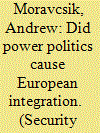

|
|
|
|
|
| Publication |
2013.
|
| Summary/Abstract |
There is much to admire in Sebastian Rosato's Europe United: Power Politics and the Making of the European Community.1 Its core argument exemplifies ambitious, theory-driven scholarship aimed at establishing a revisionist account of European integration in the 1950s, which it generalizes to a monocausally realist theory of regional integration. "The European Community," Rosato argues, "is best understood as an attempt by . . . France and Germany . . . to balance against the Soviet Union and one another."2 Since many have observed that early European integration was influenced by the geopolitical imperative of balancing against the Soviet Union and its Communist allies, this explanation is not intuitively implausible. With much realist writing having degenerated (in the "philosophy of science" sense) into a neoclassical form often indistinguishable from liberal theory, Rosato remains a real realist. At the same time, at his best, as in his discussion of the defeat of the European Defense Community (EDC), he shows himself to be a nuanced historian who recognizes the complex interaction of ideology and geopolitics in bringing about events. Europe United's explicit aim to predict the future means that it has important implications not just for scholars, but for contemporary decision makers and citizens. All this deserves praise.
|
|
|
|
|
|
|
|
|
|
|
|
|
|
|
|
| 3 |
ID:
124791
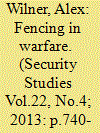

|
|
|
|
|
| Publication |
2013.
|
| Summary/Abstract |
New theoretical approaches have been developed that apply deterrence and coercion to counterterrorism. Critics have suggested, however, that in the particular case of deterring terrorism by threats of punishment, a mismatch exists between deterrent goals and counterterrorism intentions: the twin aims of destroying and deterring a single opponent is logically and theoretically incompatible. These criticisms, however, neglect to take two important factors into consideration. First, threats of punishment in counterterrorism can be applied against a wide assortment of actors involved in and associated with terrorism and political violence. Second, the concept of "intra-war deterrence" suggests ways in which a state can deter certain behavior or a specific form of warfare while engaging in open conflict with that same adversary. In exploring both factors, this article posits that states can gain coercive leverage over different actors involved in terrorism, including organizations with which they are actively hoping to defeat.
|
|
|
|
|
|
|
|
|
|
|
|
|
|
|
|
| 4 |
ID:
124789
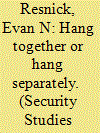

|
|
|
|
|
| Publication |
2013.
|
| Summary/Abstract |
Neorealist and liberal theories advance discrepant explanations for variations in wartime alliance cohesion. Neorealism claims that variations in cohesion are attributable to shifting international systemic conditions; liberalism argues that such differences are a function of the regime type(s) of the various alliance partners. I advance a synthetic neoclassical realist theory that proposes a given ally's decision to minimize or maximize cohesion is a function of both international systemic conditions and the regime type of the state in question. I test the three theories in US, British, and Soviet alliance decision making during World War II and find that neoclassical realism alone accounts for the behavior of all three partners over the lifespan of the "Grand Alliance" (January 1942-September 1945). The article concludes by discussing the implications of these findings for the study and practice of alliance politics, as well as for contemporary US foreign policy
|
|
|
|
|
|
|
|
|
|
|
|
|
|
|
|
| 5 |
ID:
124788
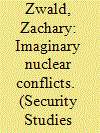

|
|
|
|
|
| Publication |
2013.
|
| Summary/Abstract |
Although the question of how policymakers arrive at their nuclear doctrine and force structure preferences is one of unparalleled importance, it has not received systematic attention in international relations. This article, therefore, develops and illustrates a behavioral model of nuclear deterrence preference formation wherein variation in such preferences is a function of the content and flexibility of one's theory-driven thinking. A policymaker determines the value of potential doctrine and force structure positions in the context of his or her beliefs about the nature of how nuclear conflict will likely begin and proceed-i.e., whether more as a result of rational and deliberate action or due to fear, misperception, and accident. This analysis challenges the dominant explanations of doctrine and force structure preference formation that are implicit in IR. It suggests how the dialogue of the deaf in domestic debates over nuclear weapons policy can be reduced in the future and provides new criteria by which to recast the proliferation optimist-pessimist debate.
|
|
|
|
|
|
|
|
|
|
|
|
|
|
|
|
| 6 |
ID:
124793


|
|
|
|
|
| Publication |
2013.
|
| Summary/Abstract |
Sebastian Rosato's admirably provocative Europe United retells the origins of the European Union (EU) as a realist story of the balance of power. While he deserves praise for a bold attempt to extend offensive realism into history's greatest instance of international cooperation, the book ultimately reads as a cautionary methodological tale about how not to support a realist argument. Realist theory has been influential mainly because it offers strong expectations about major patterns in the world-relatively unitary decision-making within states and specific kinds of foreign policies between them-but Rosato's evidence focuses on a thin version of process. He selectively cites leaders' statements about their policy choices across the story, providing no leverage on how these statements related to patterned interests within or across countries. Interestingly, a similar error weakens work by the most salient IR scholar writing on EU history, Andrew Moravcsik. Their shared problems hint at a pattern of IR scholars overlooking patterns in historical evidence.
|
|
|
|
|
|
|
|
|
|
|
|
|
|
|
|
| 7 |
ID:
124787
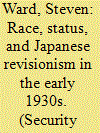

|
|
|
|
|
| Publication |
2013.
|
| Summary/Abstract |
This paper develops and illustrates a novel theoretical explanation for maximal revisionist challenges to the status quo. I argue that some rising great powers become dissatisfied with the normative and constitutive structure of the status quo and therefore incapable of or unwilling to orient themselves toward reassurance, not because of increasing capabilities but rather due to the domestic political effects produced by perceptions of status immobility-the idea that the status quo is unable to accommodate the rising state's claims to increased status and prestige. I illustrate the argument by showing that Japan's increasing revisionism after 1931 can in large part be explained by widespread perceptions of status immobility linked to Japanese understandings of the role of race in the maintenance of the Western-dominated status hierarchy.
|
|
|
|
|
|
|
|
|
|
|
|
|
|
|
|
| 8 |
ID:
124794


|
|
|
|
|
| Publication |
2013.
|
| Summary/Abstract |
The central question in Europe United is simple: how can we account for the creation of the European Community (EC)? As I emphasize in the book, answering this question involves two tasks. The ?rst is to explain why states cooperate; that is, why they join forces and coordinate their policies. The second is to explain why their cooperation takes the form it does. What accounts for states' decisions to form alliances or free trade areas as opposed to unions or integrated communities, which are rare phenomena in world politics?
|
|
|
|
|
|
|
|
|
|
|
|
|
|
|
|
| 9 |
ID:
124790
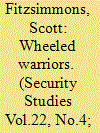

|
|
|
|
|
| Publication |
2013.
|
| Summary/Abstract |
This article engages one of the most widely discussed but poorly understood aspects of the Iraq War: the use of violence by private security companies. It explains why, despite sharing several important characteristics-coming from the same general population of military and police veterans, working for the same client during the same time period, performing the same tasks under the same client-imposed rules of engagement, and facing the same kinds of threats in the same general operating environment-the personnel who worked for Blackwater, the chief protector of US State Department employees in Iraq, killed and seriously injured far more people than their counterparts in DynCorp. The article argues that Blackwater's personnel killed and seriously injured far more people in Iraq than their DynCorp counterparts because Blackwater maintained a relatively bellicose military culture that placed strong emphasis on norms encouraging its security teams to exercise personal initiative, proactive use of force, and an exclusive approach to security, which together motivated its personnel to use violence quite freely against anyone suspected of posing a threat. If the trends established during the Iraq and Afghan Wars continue, then private security companies will see extensive employment in future conflicts. These findings, consequently, have implications that extend beyond the Iraq War and the particular firms under study. Indeed, they indicate that governments and other future clients should analyze the military cultures of the firms vying for their business and use the results as a basis for deciding which firms to hire and, to a great extent, represent them in unstable conflict zones.
|
|
|
|
|
|
|
|
|
|
|
|
|
|
|
|
|
|
|
|
|